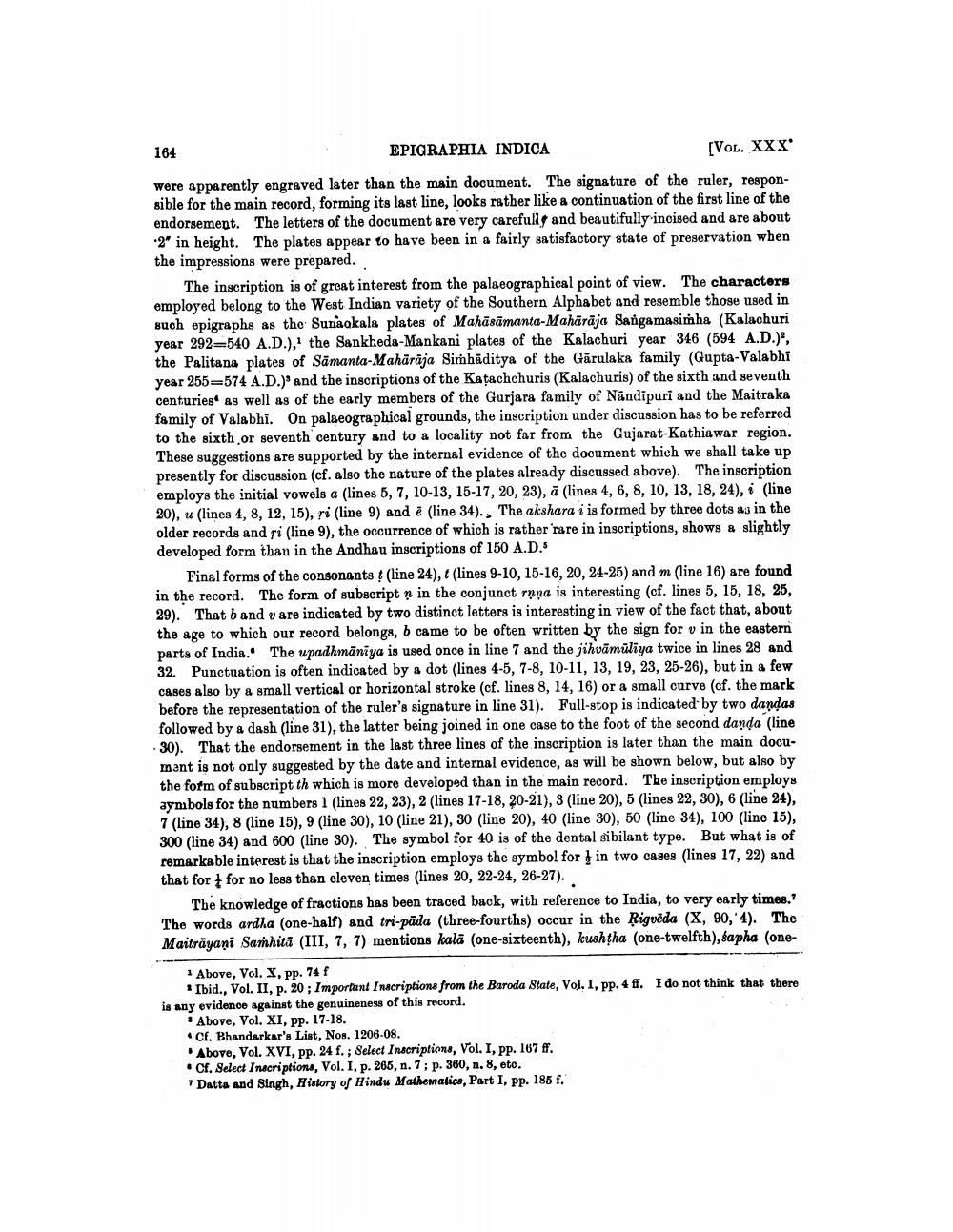________________
164
EPIGRAPHIA INDICA
[VOL. XXX*
were apparently engraved later than the main document. The signature of the ruler, responsible for the main record, forming its last line, looks rather like a continuation of the first line of the endorsement. The letters of the document are very carefully and beautifully incised and are about 2" in height. The plates appear to have been in a fairly satisfactory state of preservation when the impressions were prepared.
The inscription is of great interest from the palaeographical point of view. The characters employed belong to the West Indian variety of the Southern Alphabet and resemble those used in such epigraphs as the Sunaokala plates of Mahäsämanta-Mahārāja Sangamasimha (Kalachuri year 292-540 A.D.), the Sankheda-Mankani plates of the Kalachuri year 346 (594 A.D.)", the Palitana plates of Samanta-Mahārāja Simhaditya of the Garulaka family (Gupta-Valabhi year 255-574 A.D.) and the inscriptions of the Kaṭachchuris (Kalachuris) of the sixth and seventh centuries as well as of the early members of the Gurjara family of Nandipuri and the Maitraka family of Valabhi. On palaeographical grounds, the inscription under discussion has to be referred to the sixth or seventh century and to a locality not far from the Gujarat-Kathiawar region. These suggestions are supported by the internal evidence of the document which we shall take up presently for discussion (cf. also the nature of the plates already discussed above). The inscription employs the initial vowels a (lines 5, 7, 10-13, 15-17, 20, 23), a (lines 4, 6, 8, 10, 13, 18, 24), i (line 20), u (lines 4, 8, 12, 15), ri (line 9) and è (line 34). The akshara i is formed by three dots as in the older records and ri (line 9), the occurrence of which is rather rare in inscriptions, shows a slightly developed form than in the Andhau inscriptions of 150 A.D.
Final forms of the consonants (line 24), t (lines 9-10, 15-16, 20, 24-25) and m (line 16) are found in the record. The form of subscript n in the conjunct rnna is interesting (cf. lines 5, 15, 18, 25, 29). That band v are indicated by two distinct letters is interesting in view of the fact that, about the age to which our record belongs, b came to be often written by the sign for v in the eastern parts of India. The upadhmaniya is used once in line 7 and the jihvämüliya twice in lines 28 and 32. Punctuation is often indicated by a dot (lines 4-5, 7-8, 10-11, 13, 19, 23, 25-26), but in a few cases also by a small vertical or horizontal stroke (cf. lines 8, 14, 16) or a small curve (cf. the mark before the representation of the ruler's signature in line 31). Full-stop is indicated by two dandas followed by a dash (line 31), the latter being joined in one case to the foot of the second danda (line 30). That the endorsement in the last three lines of the inscription is later than the main document is not only suggested by the date and internal evidence, as will be shown below, but also by the form of subscript th which is more developed than in the main record. The inscription employs aymbols for the numbers 1 (lines 22, 23), 2 (lines 17-18, 20-21), 3 (line 20), 5 (lines 22, 30), 6 (line 24), 7 (line 34), 8 (line 15), 9 (line 30), 10 (line 21), 30 (line 20), 40 (line 30), 50 (line 34), 100 (line 15), 300 (line 34) and 600 (line 30). The symbol for 40 is of the dental sibilant type. But what is of remarkable interest is that the inscription employs the symbol for in two cases (lines 17, 22) and that for for no less than eleven times (lines 20, 22-24, 26-27).
The knowledge of fractions has been traced back, with reference to India, to very early times." The words ardha (one-half) and tri-pada (three-fourths) occur in the Rigveda (X, 90, 4). The Maitrayani Samhita (III, 7, 7) mentions kalā (one-sixteenth), kushtha (one-twelfth), sapha (one
1 Above, Vol. X, pp. 74 f
Ibid., Vol. II, p. 20; Important Inscriptions from the Baroda State, Vol. I, pp. 4 ff. I do not think that there is any evidence against the genuineness of this record.
Above, Vol. XI, pp. 17-18.
Cf. Bhandarkar's List, Nos. 1206-08.
Above, Vol. XVI, pp. 24 f.; Select Inscriptions, Vol. I, pp. 167 ff.
Cf. Select Inscriptions, Vol. I, p. 265, n. 7; p. 360, n. 8, etc.
"Datta and Singh, History of Hindu Mathematics, Part I, pp. 185 f.




